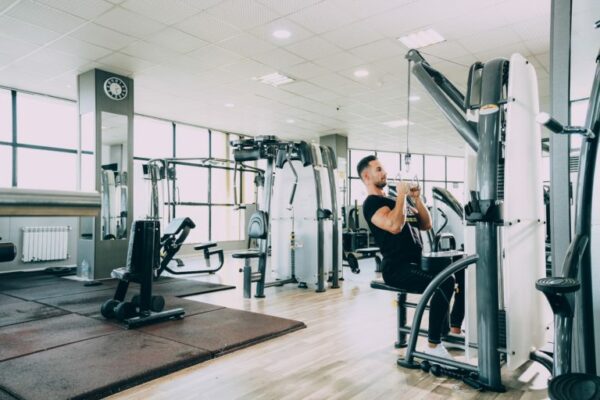How do you use a cable back workout to build a muscular body? From your traps at the top of the neck to your lats and obliques along the length of the back, nothing shows off a great routine and raw physical power quite like a well-toned back.
The back is the foundation of your body, overall build, and physique, so building robust, balanced, and well-maintained muscles is vital.

Unfortunately, however, your back also hosts many small, difficult-to-train muscles, which, if not appropriately worked, can lead to injury, an imbalanced build, or other problems.
In addition, free-weight training can be challenging for growing your rear figure precisely due to the precision and skill needed in many more complex workouts.
Some back workouts can be especially dangerous for beginners if performed alone and without proper training. Unfortunately, the answer to this problem for many is cable exercises.
These machine exercises are considerably safer and, in many cases, easier to use than free weights and can lead to a safer and more well-rounded build if appropriately used. With that in mind, we have compiled a list of some of our favorite cable back workouts for a more robust body.
1: The Seated Cable Row
This workout is excellent for beginners and pros alike; it works several primary muscle groups in the back, mainly the latissimus dorsi and the erector spinae muscles, and the biceps and triceps in the arms. This simple exercise helps develop a broad and well-defined back and can be incorporated into most routines on your upper body day.
Instructions:
Sit squarely on the cable machine, keeping your knees slightly bent and tight. Keep your back straight as you pull the bar directly towards you while pressing your shoulder blades together; touch the bar to your chest at the end of the row and repeat. Keep in mind not to lean backward; doing so can cause strain on the lower back and lead to injury.
2: The Lat Pulldown
This workout is much like the seated cable row, great for beginners, and targets the lats. However, unlike the seated cable row, which targets a broad range of muscles, the lat pulldown isolates the lats while putting a tiny train on your biceps and triceps.
Instructions:
Sit in a pulldown cable machine and position yourself with the bar directly in front of you. Depending on your height and overall preference, you may need to adjust the bar or seat height; the bar should be easily reachable from your outstretched arms.
Grasp the bar with a wide grip and your knuckles facing up; pull the bar down while squeezing your shoulder blades together. Bring the bar down until it reaches your chin while exhaling; once you complete the row, slowly bring the bar back to a heightened position while controlling its ascent. Keep your back straight and avoid arching; doing so could lead to injury.
3: The Face Pull
This intermediate exercise works out the – often ignored – rear deltoid, rhomboids, and, more minorly, your lats. In addition, this exercise creates a complete back profile by working out muscles often missed by other back workout routines.
Instructions:
Use a cable pulley machine and set the cable just above your head; if not already attached, use the two-handed handle and position yourself to reach the grips with your arms outstretched. Next, pull the cable back while externally rotating your shoulders while squeezing your shoulder blades. Finally, bring the handles back until they are just above your ears.
Finally, slowly bring the cable back forward while controlling the entire movement; while doing so, allow your shoulders and chest to roll on as the line returns to its resting position. Remember that the rear delts are a small muscle group; this exercise uses much less weight, and adding too much can easily lead to tearing or damage.
4: The Cable Upright Row
This simple workout exemplifies the usefulness of cable machines; it provides robust training to your upper arms and shoulders while creating consistent tension for a quick and decisive set. Use a staggered stance and low weight while keeping a straight back with good posture for this workout, as it’s easy to put too much strain on your shoulders when starting.
Instructions:
Use a straight bar on the lower pulley; it should rest comfortably at your waist. Bring the bar towards your armpits with an overhand grip while keeping your shoulders back and your chest lifted. Finish the row with the bar at your chin, ease it down to a resting position, and repeat.
5: The Reverse Fly
The reverse cable fly is another excellent rear delt exercise; specifically, it is a variation of the reverse dumbbell fly that more intensely targets the posterior delts while helping you form better posture.
Instructions:
Begin by standing in between the single-handed cable attachments on the cable machine. Then, with the cables at eye level, reach across your body and grab each cable opposite your hand. Next, step backward while lifting your chest and pulling, and bring your hands across and behind your body. Finally, slowly get your hands back across to a resting position. Avoid locking your elbows, and don’t lean into the movement.
Cable workouts can be a great alternative to free weights, especially when starting your back workout. However, remember that good form is vital to an effective workout, even an easier cable one.
So if you are unsure of the position or specifics, ask a gym trainer for assistance. If you want to see the rest of our workout guides, you can check out our full blog here, or if you want to check out our wellness blog to outline a diet to match your workout plan, you can check that out here.
The Last Word on the Top 5 Cable Workouts
The seated cable row, the lat pulldown, the face pull, and the cable upright row are all great exercises for back muscles. What has been your experience with these? Let us know in the comments below!
We’re always looking to add more helpful information about muscle building to our blog so you can get a well-rounded workout routine from home without going anywhere else. If you or someone you know is considering bodybuilding, share this article on Facebook or Twitter so that others can learn more about building muscle.




